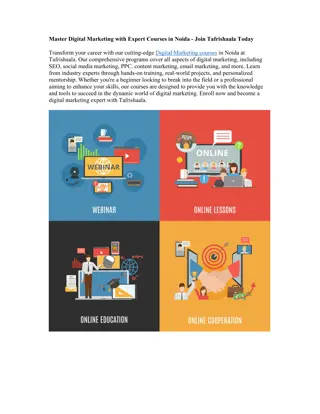Fundamentals of Marketing
The definition of marketing, different classifications of markets, and the nature and scope of marketing activities. It covers topics like acquiring and maintaining customer relations, matching needs with services/products, and the role of marketing in creating utility. Suitable for BBA students.
- Marketing Fundamentals
- Market Classification
- Customer Relations
- Marketing Functions
- Scope of Marketing
- BBA Course
- Market Analysis
- Market Segmentation
Download Presentation

Please find below an Image/Link to download the presentation.
The content on the website is provided AS IS for your information and personal use only. It may not be sold, licensed, or shared on other websites without obtaining consent from the author. Download presentation by click this link. If you encounter any issues during the download, it is possible that the publisher has removed the file from their server.
E N D
Presentation Transcript
KUPPAM DEGREE COLLEGE Sub: Fundamentals OF Marketing BBA- II SEMESTER Prepared by- K S PALANI
Definition of marketing Marketing can be said as a process of acquiring customer - & maintaining relations with them & at the same time matching needs & wants with the services or product offered by the organisations, which ensures that the organisation. "Market includes both place and region in which buyer & seller are in free competition with one another "Latin word "mercatus" Which means to trade, merchandise or a place where business is transacted.
Classification of Markets On the basis of different approaches, markets can be classified in various ways, which are mentioned below: 1) On the Basis of GeographicalAreas 2) On the Basis of Nature of Transaction 3) On the Basis of Position of Sellers 4) On the Basis of Commodities/Goods 5) On the Basis of Nature and Degree of Competition 6) On the Basis of Volume of Business Transacted
1) On the Basis of Geographical Areas i) National Market ii) International Market iii) Regional Market iv) Local Market
2) On the Basis of Nature of Transaction i) Spot Market: Spot market is that type of market where commodities are delivered immediately as soon as their transaction is settled. ii. Future Market: In case of future markets, contracts are signed for the transaction of a commodity which is to be settled on any future date, i.e., payment and delivery of product will take place in future.
3) On the Basis of Position of Sellers Primary Markets: In primary markets, organisations sell their products to some middlemen like, distributor or wholesaler. i) ii) Secondary Market: In this type of market, the middlemen like wholesalers, further sell their products to another middleman like retailers. iii) Terminal Market: Terminal market is that market where goods are finally sold to the end users of the product.
4) On the Basis of Commodities/Goods i) Produce Exchange Market: Sale and purchase of only one commodity takes place 'produce exchange markets' and these markets are set-up and managed by the buyers and sellers of that commodity. ii) Manufactured Goods Market: Manufactured goods are bought and sold in these types of markets. iii) Bullion Market: Commodities like gold and silver are bought and sold in these types of markets. iv) Stock Market: Mutual funds, equity shares. Bonds, debentures, etc., are bought and sold in these types of markets.
5) On the Basis of Nature and Degree of Competition i) Perfect Market: If the market fulfils following conditions then it can be referred to as a perfect market: a) Sellers and buyers are huge in number, b) Similar products are offered by all the sellers, ii) Imperfect Market: The market is referred to as imperfect market, if at least one of the afore mentioned conditions is not fulfilled.
6) On the Basis of Volume of Business Transacted Retail Market: In these types of markets goods are directly sold to end consumers. End consumers buy goods for personal consumption and not for making profit from it. i) ii) Wholesale Market: In these markets, dealers or retailers buy goods in bulk quantity for the purpose of re-sale. iii) Industrial Market: In industrial markets, goods are bought in bulk either for consumption or for the purpose of further processing on it, e.g., raw material.
NATURE OF MARKETING MANAGERIAL FUNCTION HUMAN ACTIVITY ECONOMIC FUNCTION BOTH ART AND SCIENCE CUSTOMER CENTRIC CONSUMER ORIENTED GOAL ORIENTED INTERACTIVE ACTIVITY DYNAMIC PROCESS CREATES UTILITY
SCOPE OF MARKETING Collecting Feedback From Customer Selling of Product Product Design Implementation of Product Pricing of Product Distribution Channels Publicity of Product Selection of Layout























